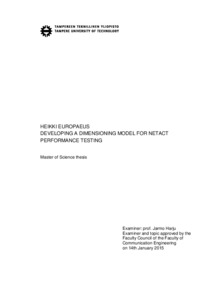Developing a dimensioning model for NetAct performance testing
Europaeus, Heikki (2015)
Lataukset:
Europaeus, Heikki
2015
Signaalinkäsittelyn ja tietoliikennetekniikan koulutusohjelma
Tieto- ja sähkötekniikan tiedekunta - Faculty of Computing and Electrical Engineering
This publication is copyrighted. You may download, display and print it for Your own personal use. Commercial use is prohibited.
Hyväksymispäivämäärä
2015-03-04
Julkaisun pysyvä osoite on
https://urn.fi/URN:NBN:fi:tty-201502181073
https://urn.fi/URN:NBN:fi:tty-201502181073
Tiivistelmä
In recent years, mobile technology has taken huge steps in equipment as well as network-side development. This has made possible to develop new type of mobile services and applications. Therefore the requirements for data rates have been increasing rapidly and this has created a need for even more efficient network monitoring and management tools. Nokia’s solution for network management is called NetAct operations management system. The research problem in this master’s thesis is the quality of dimensioning models used in NetAct performance testing. The currently used dimensioning model in testing is based on expert estimates of operator networks and there is no information of the reliability of the dimensioning model.
Solving the dimensioning problem started by collecting actual operator data used by the customer support team. The operator data included information about the number of network elements and their status. When enough material was collected from the operator networks, the material was put into an Excel file. This time-consuming operation gave a motivation for writing automation program for data gathering. The automation program was written with Java. From the compiled Excel file, ratios for the element types and the minimum, average, median and maximum values for the number of network elements could be calculated. The dimensioning model is based on these network element ratios and calculated minimum, average, median and maximum values.
The automation significantly speeded up the gathering of data from the operator files to the Excel file; this also eased the collection work. The collected operator data revealed that the currently used dimensioning model represents operator networks fairly accurately, but it also revealed that the testers test the NetAct with oversized networks compared to the network size that operators really have. The developed dimensioning model represents the operator networks more accurately, and therefore it enables more accurate performance testing of NetAct.
Solving the dimensioning problem started by collecting actual operator data used by the customer support team. The operator data included information about the number of network elements and their status. When enough material was collected from the operator networks, the material was put into an Excel file. This time-consuming operation gave a motivation for writing automation program for data gathering. The automation program was written with Java. From the compiled Excel file, ratios for the element types and the minimum, average, median and maximum values for the number of network elements could be calculated. The dimensioning model is based on these network element ratios and calculated minimum, average, median and maximum values.
The automation significantly speeded up the gathering of data from the operator files to the Excel file; this also eased the collection work. The collected operator data revealed that the currently used dimensioning model represents operator networks fairly accurately, but it also revealed that the testers test the NetAct with oversized networks compared to the network size that operators really have. The developed dimensioning model represents the operator networks more accurately, and therefore it enables more accurate performance testing of NetAct.
